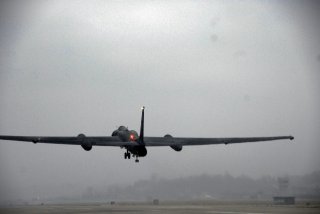Why the Famed U-2 Spy Plane Was Designed with Only 2 Wheels
With only two wheels, the U-2’s pilot would attempt to land the plane and slow it down without crashing either of its enormous wings into the ground.
When it first took to the skies in 1955, the Lockheed U-2, nicknamed the “Dragon Lady,” was like nothing that had flown before it. The spy plane was far from the biggest plane in the sky; the B-52 Stratofortress, which had a wingspan nearly twice that of the U-2, had already entered service in the U.S. Air Force. But while the B-52 was built to carry a payload – either cargo or bombs, depending on the need – the U-2 was built to spy.
To do that, the plane needed to fly high, well beyond the altitude limits of the fighter jets that the Soviet Union operated during the 1950s. The plane’s designers at Lockheed’s “Skunk Works” experimental aircraft division partially solved this problem by giving it an enormous wingspan of more than one hundred feet. The plane’s wings made it unwieldy, but gave it a major height advantage over Soviet fighter jets; it could fly up to 70,000 feet. Even at that altitude, its sophisticated cameras gave it the ability to provide a steady stream of intelligence to U.S. analysts.
The other variable controlling the plane’s altitude was its weight, and the designers at Skunk Works worked to reduce it however they could. One of Lockheed’s executives, John Carter, hit upon an innovative way to do this: Strip the plane of its landing gear.
Carter’s suggestion was not as suicidal as it sounded when Skunk Works’ Clarence “Kelly” Johnson considered it. Instead of giving the U-2 a typical fighter jet’s three-wheeled landing gear, Skunk Works cut back and gave the spy plane only two – each placed in the center of the plane, akin to a bicycle’s wheels. The decision shaved critical pounds off the aircraft’s weight, helping it to achieve the desired altitude. When it came time to take off, two additional wheels would be attached to the plane, one on each wing; after takeoff, they would be dropped, and the plane would be free to ascend to the needed height.
Landings were another matter. With only two wheels, the U-2’s pilot would attempt to land the plane and slow it down without crashing either of its enormous wings into the ground. For this purpose, the pilot would be assisted by a crew of ground personnel, led by a “chase car,” which would drive after the landing plane and radio back information such as its height and position to the pilot.
After the U-2 was slowed down enough, one of the wings could be tipped onto the ground to bring the plane to a stop; a titanium skid plate underneath each prevented the wing from taking damage during this phase.
This design, like much else about the U-2, was unwieldy and difficult to master, and innovations in the years since the 1950s would help modern U-2s to land more normally. But, in spite of its ugliness, the system works as it is – and it has helped the U-2 to carry out its critical intelligence missions for nearly seventy years.
Trevor Filseth is a current and foreign affairs writer for the National Interest.
Image: U.S. Air Force Flickr.

